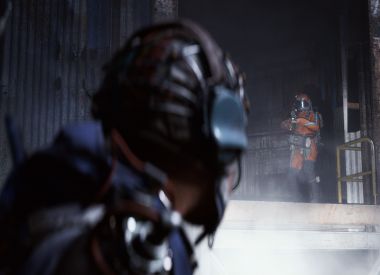Lightgun games are staples of a good arcade, giving players a bulky and satisfying plastic gun to mow down endless waves of virtual enemies. Depending on the game, some of these experiences have pedals, special buttons, vibrations, or even moving controllers. While the Mars Lightgun system from PDP Games does feature some pretty solid at-home hardware, unfortunately the software doesn’t make the experience all that worthwhile.
To provide a working lightgun experience, players first plug in the included camera. This helps line up your shots for the camera to see them. This did take a somewhat annoyingly long time to set up, but once we had it locked in, the experience was great.
When using the lightgun, I could easily aim exactly where I wanted to, and pulling the trigger resulted in scoring quick and accurate shots with ease.

Reloading is handled by grabbing the front barrel of the gun and sliding the orange part back. There is also a button on the back of the gun that served as a way to switch between weapons for one of the available games, Voyage of the Dead. The biggest problem with having the reload require a second hand is it makes playing with two guns or playing while holding a drink tougher. That said, you can also press the top of the gun into your leg to reload if you are feeling lazy.
Overall the Mars lightgun is a great peripheral that offers easy plug-and-play setup. Aside from lining up the camera, the overall time it takes to get the system up and running is only a few minutes. When playing, our guns did seem to somewhat regularly become disconnected before quickly reconnecting. This wasn’t a major issue, but it was common to be playing as Player One, only to get disconnected and reconnected as Player Two.
However, what good is the peripheral if the game it is made for isn’t very fun? That was the issue my buddy and I had when working our way through one of three games for the Mars lightgun, Voyage of the Dead. As the name might suggest, Voyage of the Dead is a first-person zombie shooter, where players move on a track through a cruise ship filled with all sorts of undead creeps.
This is pretty standard arcade lightgun fare, and if you’re looking for an authentic arcade experience, you’ll certainly find it here. However, we don’t have to live by the constraints of machines designed to suck in quarters. There should be a way to resume after dying instead of being forced all the way back to the beginning. Additionally, the different characters available all shout out their catchphrases so repetitively it makes you almost want to stop shooting the zombies so your character might finally shut their mouths.
There are a number of other smaller games included in Voyage of the Dead, like a shooting gallery and a two-player competitive mode where players see who can score the most points by clearing a small wave of zombies. Completing these modes unlocks additional characters to use in the main campaign, but these side modes are surprisingly difficult. Expect to have to put in work if you want to play as someone outside of the already unlocked cast.
I also had the opportunity to try out Qubit’s Quest, which is a much different take on traditional lightgun games. Instead of gunning down enemy after enemy, Qubit’s Quest is actually a puzzle/platformer game. Players use the gun to clear out enemies and obstacles, while also getting the main character (a robot dog) to jump. Players can also pick up different weapons and complete side objectives during each level.
It’s a clever concept, and there are some smart ideas to be found in Qubit’s Quest, but the controls can sometimes be a little confusing. Additionally, there’s no aiming reticle on screen, meaning you are never quite sure where your shots are ending up. Typically, I rained shots down on the screen, using the impacts of previous shots to guide me.
Overall the Mars Lightguns offer some solid and easy to use at-home arcade action. The guns themselves are hefty and sturdy, and the camera system accurately reads shots once you manage to get it all set up. Unfortunately, the software included with the lightguns aren’t necessarily interesting enough to get me to use the whole system more.
The Mars Lightguns are available now for Xbox One and PS4. Starter Packs include one Mars Lightgun and the camera along with one of the three games that use the hardware. Additional guns are also available separately, and the games can be purchased on the Xbox One or PS4 stores.


















